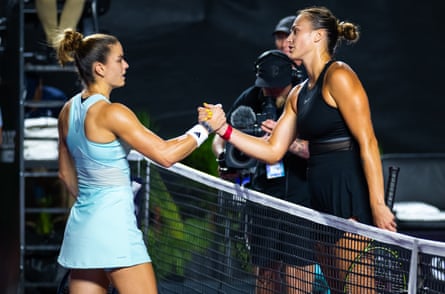In the leadup to the WTA’s season finale each year, the competing players normally hope to spend their days making final preparations on the stadium court. There are, after all, countless details to fine-tune, from adapting to the speed of the court surface, to the wind and sun.
Not this time. As the eight best tennis players in the world arrived in Cancún last week for the WTA Finals, the stadium was still a messy building site and the hard court surface had yet to be laid. The venue is a temporary structure erected at short notice on the grounds of a luxury hotel resort and, to the displeasure of the players, it was not ready until the day before play began on Saturday morning.
“I’m not very happy that this is the first day we hit on the stadium,” said Ons Jabeur. “This is such a big event. We should have been able to be ready and hit on the court. Hopefully this will never, ever, ever happen again. Like, ever …”
What may be a small problem in isolation is one of countless issues this season that have left some players disenchanted with their governing body and its amateurish failings. It also presents serious questions about the management of the WTA as it approaches a tipping point in its history.
The 2023 WTA Finals were never supposed to be held in Mexico. In 2018, the tour sealed a 10-year contract said to be worth nearly $1bn for the WTA Finals to be held in Shenzhen between 2019 and 2028. At that time, the WTA was aggressively expanding into China, a strategy that has had dire consequences for the organisation.
Four months after the controversial first and only edition in Shenzhen, Covid-19 struck. Since its cancellation in 2020, the WTA Finals has flitted from city to city without a home. After Guadalajara 2021, last year Dallas-Fort Worth was decided on only in September. With only two months to promote the event, the crowds were predictably pitiful.
History repeated itself this year as the tour again failed to finalise the location until the very last minute. After a highly publicised board vote during the US Open, the tour announced Cancún as the winning bid on 7 September, rejecting lucrative offers from Saudi Arabia and the Czech Republic.
After learning of his defeat, Tomas Petera, the organiser of the Czech bid, slammed the WTA. He argued that the Czechs had offered a far greater deal: a four‑year commitment with $15m prize money and a $6m fee to the WTA in a market that would provide both the prestige of full crowds and lucrative earnings. Instead, the WTA will take on a heavy financial burden in Cancún and players will receive $9m prize money. It is widely believed that Cancún will act as a stopgap until next year, and Saudi Arabia may be on the cards again.

The turbulence of the WTA Finals since the pandemic began reflects the tour’s difficulties. The event is the tour’s biggest financial asset and it has historically provided significant revenue. After the WTA made a loss of only $1m in 2019, according to its public accounts, it has had losses of $16.5m in 2020 and $15.1m in 2021.
With such difficult finances, the WTA has failed to sufficiently promote the sport. Its streaming platform, WTA TV, consistently has technical issues and, six years after its launch, still does not have a mobile app. While the ATP’s significantly bigger team floods fans with varied off-court and on-court social medal content, following the lead of Formula One, the WTA’s YouTube account produces short highlights and little else. The WTA has not posted on TikTok in three years. Over the past decade, the prize money gap between the ATP and WTA has widened significantly.
With its back to the wall, the WTA announced this year that CVC Capital Partners would make a $150m investment in the tour, with the private equity firm receiving a 20% stake in return. From next year the tour structure will change dramatically and a new commercial arm of the tour, WTA Ventures, will be born.
after newsletter promotion
For the players, scheduling rules will change, with top players heavily restricted from playing smaller WTA 250 events so that they will compete in the bigger events more frequently, increasing the likelihood of establishing memorable rivalries. The WTA has also said there will be greater investment in marketing and the tour will follow a path to equal prize money with the ATP over the next decade. Given its recent organisational issues, it remains to be seen how faithfully WTA will live up to these grand pronouncements.
Despite these off-court problems, this has been a strong year on the court and the cast for the season finale is impressive. Iga Swiatek has followed up her all-time great 2022 season with an excellent, consistent year and Aryna Sabalenka, the No 1, has proven herself a worthy rival. The year-end No 1 ranking will be decided between them in Mexico.
After years of suffocating hype, Coco Gauff came of age in incredible scenes at the US Open, winning her first grand slam title. She joins Swiatek’s round‑robin group alongside Jabeur and Wimbledon champion Marketa Vondrousova, with Jabeur and Vondrousova adding greater dimension to the tour with their varied playing styles.
Sabalenka’s group, meanwhile, includes Elena Rybakina, who has backed up her 2022 Wimbledon title with a stellar season, and perennial top‑10 players Jessica Pegula and Maria Sakkari. The players will battle hard on the court, of that there is no doubt, but the onus is on the WTA to build a structure around them that is worthy of their talents.
